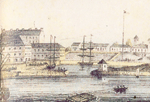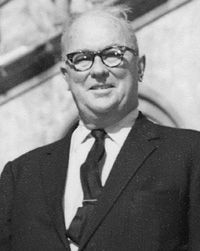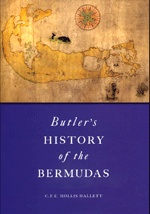

|
This month
Closure of HM Dockyard A brief noonday ceremony made it official—HM Dockyard closed down its mammoth operation in the west end, ending an era lasting nearly 200 years. It began in 1793, when the British purchased 141 acres of land at Ireland Island to establish a base in the North Atlantic after losing the war of independence to its former colony, the United States of America. Bermuda’s position, midway between Britain and its other colonies in the Canada and the Caribbean, was of strategic importance. Construction of HM Dockyard, which was called the ‘Gibraltar of the West’, began in 1809 with slaves and free black men, working under the supervision of British engineers, supplying the labour. The next set of workers were British and Irish convicts, who were shipped across the Atlantic and holed up in airless hulks moored off Dockyard. Convicts provided the bulk of labour from 1824 to 1863. By the end of the 19th Century, workers were being brought in from Caribbean islands, such as Jamaica, St. Kitts, Nevis and Saba. Dockyard, which had its own movie theatre, hospital, church, schools and shops, was of major economic importance to Bermuda, employing more than 1,000 locals. A major legacy was its apprenticeship scheme, where hundreds of Bermudians, black and white, received a rigorous training in trades such as plumbing, carpentry and masonry and as shipwrights. When Dockyard closed down, 50 Bermudian apprentices were sent to Portsmouth, England to complete their training. News that the Dockyard was to be closed came as a major shock to Bermuda, although the establishment of U.S. bases at Morgan’s Point in Southampton and St. David’s in 1941 lessened its impact on the economy. The pullout took place in phases and the leave-taking was an emotional one. In September 1950, 250 navy personnel had been shipped back to England, leaving 180 to be repatriated over the next few months. Barbadians working at Dockyard were also sent back home in two shiploads. The closure turned a base that had hummed with activity into a ghost town. Seven officers and 20 sailors took part in the closing ceremony that saw the British Navy flag, the White Ensign, taken down from the flagpole in front of Commissioner’s House. The Royal Gazette reported that by the end of the ceremony, “an atmosphere of desolation had settled over the area.” According to the report: “No longer would ships berth alongside the deserted arms for repair or seek the sanctuary of the big drydock.” Sources: The Royal Gazette, September 17 and 18, 1950, and April 2, 1951; Bermuda: Five Centuries by Rosemary Jones; Bermuda Journey by William Zuill.
|
|
In the News
- Bermuda Day restored Go fly a kite! One of the island’s most enduring traditions will be celebrated this month—by Christians and non-Christians alike. On Good Friday, March 21, thousands of multi-coloured, tissue paper kites will take to the skies—if the winds co-operate. Legend attributes Bermuda’s kite-flying tradition to a minister who was trying to explain Christ’s resurrection to a Sunday school class. Government reverts to Bermuda Day Government has done an about-face on its plan to change Bermuda Day to National Heroes Day. Culture Minister Dale Butler told a press conference the rethink came in response to a public outcry. He also announced this year’s Bermuda Day will be observed on Monday, May 26 because May 24 falls on a Saturday. The theme for Heritage Month 2008, which is observed throughout May, and Bermuda Day is ‘Life in Old Bermuda.” See our May 2007 home page for the origins of Bermuda Day. Masterworks gets a permanent home Masterworks Museum of Bermuda Art has opened in the Botanical Gardens in Paget. It’s the culmination of a vision that began 12 years when founder Tom Butterfield began tracking down works of art painted during the late 19th and early 20th Century by artists while vacationing in Bermuda. The Bermuda Historical Society Museum has reopened following a facelift that has given it a fresh look and more space, and made it more diverse. Now original portraits of Sir George and Lady Somers and writer-historian Terry Tucker share space with a drawing of May 24 Marathon Derby runner Stanley Burgess. A new book has just rolled off the Bermuda Maritime Museum presses. Butler’s History of the Bermudas, written by 17th Century Bermuda governor Nathaniel Butler, and its language modernised by editor Clara Hallett, is now available at the Museum and in bookstores. Price is $40. |
|||||||||
| © 2008 Bermuda Biographies All rights reserved |
|||||||||||


